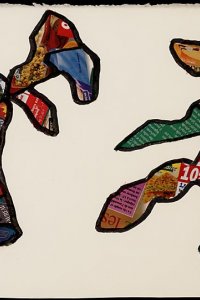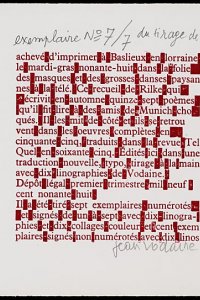Sept poèmes : automne tardif. Sieben Gedichte : Spaetherbst
Year: 1998
Author: Rainer Maria Rilke (1875 - 1926)
Artist: Jean Vodaine (1921 - 2006)
Publisher: Jean Vodaine
A German in french
The multilingual area of Alsace-Lorraine - German and French territory by turns throughout the course of history - is perfectly suited for a bilingual edition of the work of Rainer Maria Rilke. Rilke first visited Paris in 1902 and met sculptor Auguste Rodin, about whom he wrote a monograph and for whom he worked as a private secretary for a short period (1905-1906). This work satisfied neither the client nor the employee, but Rodin - and Cézanne - did teach Rilke to look, as he described it himself. This resulted in Die Aufzeichnungen des Malte Laurids Brigge (1910) with the famous opening lines: 'So, also hierher kommen die Leute, um zu leben, ich würde eher meinen, se stürbe sich hier.' ('So this is where people come to live, I would rather think they came here to die.'). He also adopted Rodin's work ethic: 'one must always work'. Besides his German poetry, Rilke also wrote poems in Russian and in French, occasionally assisted by his friends. He knew Paul Valéry, André Gide and Roger Martin du Gard, who remembered Rilke sitting next to him at the Bibliothèque nationale and reading several books at once. In June 1926 (seven months before Rilke's death), Vergers, suivi des Quatrains valaisans was published (printed in late March), and his Poèmes français were published in a single volume in 1935.
The seven poems that Vodaine published would not find a publisher during Rilke's lifetime. He wrote them during World War I in Munich (1915), but his friends there found these phallic poems too shocking. He had spoken with Lou Andréas Salomé in 1913 about the erection and the physical act of love as a theme for poetry. This theme was unavoidably linked to another theme: death. The poems were later included in the second volume of his collected works (Sämtliche Werke, Zweiter Band, 1956). A French translation by Jacques Legrand was published in the magazine Tel quel (1965), but Vodaine produced a new translation, did the typesetting himself and also provided them with illustrations of his own: ten linocuts. Vodaine never printed large numbers of his books, as he had to print the text himself as well. In this case, he did that in 1998 during the carnival (mardi gras), while following the festivities on television. The colophon mentions masquerades and barn dances explicitly. The illustrations and the colophon were printed in red. Vodaine produced a total of 107 copies, seven of which were numbered, signed and expanded with 10 loose colour collages in the style of Niki de Saint Phalle. This copy is number 7 of that edition.
Bibliographical description
Description: Sept poèmes : automne tardif = Sieben Gedichte : Spaetherbst / Rainer Maria Rilke ; [trad. nouvelle, typographie et 10 linographies de Vodaine]. - Baslieux en Lorraine : Jean Vodaine, 1998. - [25] p. : ill.; 26x36 cm
Printer: Jean Vodaine (Baslieux en Lorraine)
Edition: 107 copies
This copy: Number 7 of 7 copies signed by the artist
Note: With 10 collages in colour by Jean Vodaine
Shelfmark: KW Koopm E 40
References
- Paul van Capelleveen, Sophie Ham, Jordy Joubij, Voices and visions. The Koopman Collection and the Art of the French Book. The Hague, Koninklijke Bibliotheek, National Library of the Netherlands; Zwolle, Waanders, 2009
- Paul van Capelleveen, Sophie Ham, Jordy Joubij, Voix et visions. La Collection Koopman et l'Art du Livre français. La Haye, Koninklijke Bibliotheek, Bibliothèque nationale des Pays-Bas; Zwolle, Waanders, 2009
- Ralph Freedman, Life of a poet: Rainer Maria Rilke. New York, Farrar, Straus and Giroux, 1996
- Maurice Martin du Gard, Les mémorables, 1918-1945. Paris, Gallimard, 1999
- Jean Vodaine. Bassac, Plein Chant, 1995. (Special no. of Plein chant, (1995) 57-58)
- Rainer Maria Rilke, De aantekeningen van Malte Laurids Brigge. Amsterdam, Balans, 1992
- Rainer Maria Rilke, 'Sept poèmes', in: Tel quel, (1965) 22 (été), p. 76-78

![Portret van Rilke: linosnededoor Jean Vodaine (p. [2])](/sites/default/files/styles/galerie/public/images/portret-rilke-linosnede-jean-vodaine.jpg?h=f0f018ed&itok=tMZlHlwp)

![Pagina [3]](/sites/default/files/styles/galerie/public/images/les-sept-poemes-p3.jpg?h=383fc4a2&itok=5tF4cRNk)

